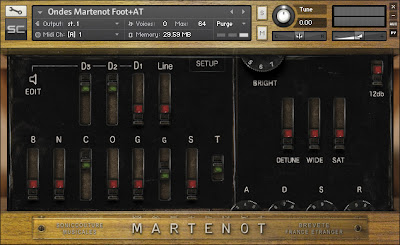Soniccouture - Ondes | 20/08/11 | Kontakt | 1.47 GB
LUTHIER DE L'ELECTRONIQUE
Perhaps one of the most enigmatic musical instruments of all time, The Ondes Martenot ( literally ‘Martenot Waves’) was invented by Maurice Martenot in 1928. The original unreliable tube-based design was refined and later models remained in production until 1988. An interesting overview of the instrument can be seen on Youtube.
The Ondes Martenot has been used in many film scores first dating from 1931; Odna by Shostakovich, Lawrence of Arabia (1962), Ghostbusters (1984), A Passage to India (1984), through to present day movies such as Amélie (2001) and recently There Will Be Blood (2007) by Jonny Greenwood of Radiohead.
THOMAS BLOCH RETURNS
Thomas Bloch is perhaps the most renowned Ondist in the world ; when great musicians and producers are inspired by the sound of the Ondes Martenot, it is often him they turn to. Radiohead, Tom Waits and Damon Albarn have all worked with him.
So, we knew Thomas was the only man to help us to recreate this bewitching instrument..
PLAYING THE ONDES MARTENOT
The instrument produces sound using oscillators, as with a conventional analogue synthesiser, but it is the various unusual methods of control which give the instrument its' unique character :
The Keyboard and Ring Controller
LE RUBAN - THE RING CONTROLLER
The most famous is the metal ring, which is worn on the finger of the right hand. The ring is not used when the keyboard is being played, like the ribbon controllers we are used to.
When the Ondes is switched to ‘ring mode’ (au ruban), the ring becomes the sole method of determining pitch ; a very skillful technique, particularly so when you consider that in order to produce any sound at all, you must simultaneously manipulate the clear, lozenge shaped device, known as the touche d’intensité..
The touche d’intensité is a large button on the control drawer of the Ondes Martenot, and is pushed and tapped to produce the tone of the instrument ; in effect , it controls the volume envelope of the instrument. The touche d’intensité is controlled with the left hand while the player uses either the ring or the keyboard to produce the melody.
Next to the touche d’intensité are a series of switches and dials which control the oscillators and create the timbre of the note - as well as send levels to the three loudspeakers.
Filesonic:
Fileserve:



 20:09
20:09
 Samplerion
Samplerion




 Posted in:
Posted in: 








0 comentarios:
Publicar un comentario